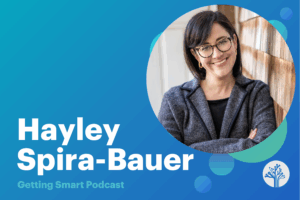20 Math and ELA Tools that Support English Language Learners

As part of our #SupportELL series, we have summarized some products, services and tools that support English Language Learners (ELLs) and their teachers. To gather information from education technology companies, Getting Smart invited education technology companies to fill out a form to provide information on their ELL adaptations.
This is not an endorsement of any particular product, tool or service. When making decisions about specific tools for teachers and students, we strongly encourage research and application demonstrations for applicability in your context, as well as alignment to current new state standards.
If you would like to join the conversation and share other tools, please use #SupportELL on social media to contribute specific technology-enabled tools.
We know tech tools, when integrated with other research-backed instructional practices, can support ELLs. Consider the following user case study:
|
Math Supports for ELLs Students at Dunbar Elementary School are given access to computers and use DreamBox Learning for closing gaps in math. All students, regardless of academic achievement, work together using DreamBox Learning. Students of various abilities are able to work at their own pace. This district approach is part of what they call the Grade Level Proficiency Project (GLPP). “The independent math assessment, Let’s Go Learn, documented incredible progress from January 2014 to May 2014 for students in the GLPP: 91 percent of second-graders were at second- or third-grade level—up from 65 percent—and 93 percent of third-graders were at third- or fourth- grade level—up from 43 percent. Principal Blake of Dunbar Elementary summed up her assessment of the program, ‘In my 31 years in education, this is one of the most exciting programs in which I have been involved. Already I have teachers coming up to me asking when they can be trained, get involved and be part of the GLPP model. Schools need many kinds of teaching, many kinds of technology tools and many kinds of practices to ensure all students are at grade level in reading and math by the third grade. GLPP is the model to get us there. I am grateful beyond measure for the support and opportunity to reach this goal.’”
|
The following table includes a list of tools and products, a brief description, their typical use (Supplemental, Intervention or Core Curriculum).
| Tool/Product | Brief Description | Ideal Use | Use (1) | Grade Level(s) |
| Achieve 3000 | A patented, cloud-based solution that delivers daily differentiated instruction for nonfiction reading and writing that’s tailored to each student’s Lexile® reading level. Accommodates ELLs through differentiated instruction and accelerated learning. Further supports language growth with a standards-aligned custom curriculum that integrates phonics and fluency practice. | Used in a mainstream classroom, this is often used in a flex rotation model, where teachers can work with small groups of students. Students take initial Lexile reading tests to determine groupings. | S/I | 2-12 |
| DreamBox Learning Math | DreamBox Learning Math combines Pre-K-8 math curriculum in English and Spanish with a game-like learning environment and real-time feedback for each student. For ELLs, DreamBox Math provides visual interactive tutorials, embedded vocabulary, guided audio/ visual support and formative assessments. | Typical use is as part of a blended learning model, but schools see increased learning outcomes across all implementation models. | S | PreK-8 |
| Mirrors & Windows (EMC) | Mirrors & Windows is a diverse English Language Arts program that covers reading, writing, speaking, listening and language (grammar and vocabulary). The program provides a differentiated instruction supplement for ELLs which includes guided reading questions, vocabulary development lessons, speaking and listening activities, fluency assessments, and selection summaries in Spanish with audio support. Also, ELL-specific activities are annotated in the Teacher’s Edition margins. | Mirrors & Windows English Language Learner support is designed to be used in the regular 6-12 English Language Arts classroom as differentiated instruction for non-native English speakers. | C | 6-12 |
| Eureka Math (EngageNY Math) | Math curriculum that spans 14 grade levels and is fully aligned to the Common Core State Standards. Currently working in conjunction with New York State Education Department (NYSED) to translate the curriculum modules into the top 5 languages spoken in New York State: Spanish, Chinese, Arabic, Bengali, and Haitian Creole. | Eureka Math is a complete and coherent curriculum that can be used as a primary curriculum across all grade levels. | C | Pre-K-12 |
| Escalate English (HMH) | The specific ELL tools emphasize strong language, literacy and communication development through engaging and empowering lessons and activities. | Can be used in daily instruction for ELD. | C | 4-8 for this specific product |
| Lexia Reading Core5 | An adaptive, personalized reading program designed for students of all abilities. Core5 is designed to support ELL users through a scope and sequence with adaptive branching in all of the lessons that includes direct instruction if the student struggles with an activity. Core5 also supports ELL students through the provision of directions and instructions in six languages: Spanish, Haitian-Creole, Arabic, Mandarin, Portuguese, and Vietnamese. Vocabulary strategies are emphasized and include picture and verbal supports as well as off-line instructional resources. | In the classroom for 20-80 minutes each week. | S/I | Pre-K-5 |
| LightSail Education | An adaptive reading platform with access to over 80,000 literary titles. ELL students access an embedded dictionary with Spanish and Mandarin translations, hundreds of Spanish language texts, and text-to-speech functionality. | Ideally, students spend at least 25 minutes each day on LightSail. | S | K-12 |
| My Math by McGraw-Hill | The McGraw-Hill My Math Program has adopted three levels of language proficiency: Emerging, Expanding and Bridging used by the World-Class Instructional Design and Assessments Consortium (WIDA). The program provides techniques for differentiating instruction to accomodate all learners, including ELL students. | Ideally, students use both online and in-person instruction with tools. | C | K-12 |
| Newsela | An online collection of daily news articles from media sources. The platform and content allows ELLs to access relevant non-fiction content in both English and Spanish and at 5 different reading levels. ELLs can toggle between different levels in English and Spanish. Content is accompanied by standards- aligned quizzes. so teachers can track student progress. | To be used daily in the classroom to build reading comprehension and literacy while providing an engaging way for students to learn about the world around them. | S | 2-12 |
| Quill | English grammar activities for K-12 students covering 42 language standards. Quill offers verb tense activities targeted at ELLs. They are about to launch a text to speech feature so that students can listen to the text while reading. | Teachers use as a “do now” activity at the beginning or end of class. | S | 3-10 |
| Read 180 | A comprehensive blended learning solution that provides strategic reading intervention in three stages, each with age-appropriate content. Read 180 has solutions for ELLs through inclusion of explicit academic language instruction, opportunities for structured academic discussion, scaffolded writing techniques and added teacher support. | A flexible rotation model designed to help teachers address students at all levels of intervention. Districts can successfully implement READ 180 in a single, extended or double period with up to 27 students per class. | S/I | 4-12+ |
| ReadWorks | Free, research-based content, teacher guidance and integrated tools for teaching reading comprehension. Some specific ELL adaptations include: images that accompany passages; images that support specific academic vocabulary words at the lowest reading levels; images that are incorporated into the lowest level question sets; graphic organizers associated with lessons and units; Spanish cognates (where applicable) in vocabulary support offering; questions focusing on signal words and syntax as part of most recent question set template; audio versions of texts (currently in development); and a growing number of visual and multimedia supports. | Allows for an incredible amount of flexibility in use. Can be used as a supplement or main resource for reading comprehension materials and curriculum. Ideally, teachers should have all their students, including ELLs, read at least one nonfiction article every day. | S | K-12 |
| i-Ready | i-Ready is an adaptive diagnostic and growth measure-targeted assessment of grade-level standards and individualized student online instruction. i-Ready helps teachers deliver differentiated instruction for ELLs and incorporates several forms of automated support via audio, visual, and tactile components such as physical cues (like pointing or facial expressions), symbolic cues (like pictures and icons) and auditory cues (like asking a question). | Case by case, based on the proficiency level of the students. Students of the same or similar proficiency level can be placed together in a small group, while classrooms that have more heterogeneous ELL designations would be using i-Ready on an individual basis at the student’s pace. | S/I | K-8 |
| Reasoning Mind | An online algebra-readiness mathematics program. There is a Spanish language glossary. Implementation Coordinators that assist teachers can also provide guidance, such as partnering students. | Online curriculum in sequential objectives where teachers monitor formative and summative data to assist students with quick redirections or more in-depth interventions if they are struggling. | S | 2-7 |
| ST Math (MIND Research) | Game-based instructional software designed to boost math comprehension and proficiency through visual learning. ST Math supports ELLs as the non-language-based software presents mathematical concepts visually without language to promote greater conceptual understanding. | Students of all levels, math proficiency and English language proficiency are able to benefit from ST Math because it is visual and doesn’t rely on language for learning. | S | Pre-K-12 |
| ThinkCERCA | A personalized literacy platform that helps teachers grow students’ critical thinking powers in reading and writing with lessons in English language arts, science, social studies and math. All lessons currently feature vocabulary support, topic overviews to support big ideas and development of schemas, fluent and expressive audio readings of all texts, sentence frames to support development of productive academic language, graphic organizers and a structured writing process that helps students organize their thinking and develop conceptual understanding to facilitate comprehension. Starting in the fall of 2016, ThinkCERCA will provide lesson-specific supports for ELL students and their teachers for all applied writing lessons. | A whole-team implementation in which students use ThinkCERCA three to five times per month across the curriculum. | S |
4-12
|
| WriteLab | An online writing platform offering immediate and actionable responses to improve writing. For ELLs, graphic organizers can support the writing process from start to finish. | Instructors can use WriteLab in the classroom for peer review, and students can use WriteLab from any computer or mobile device. | S | 11-12 + postsecondary |
| WriteToLearn | A literacy tool that provides essay writing to build writing skills, summary writing to develop reading comprehension and vocabulary exercises to expand students’ word knowledge. The tool supports ELLs with ELL-specific essay prompts, translated instructions and feedback in Spanish and Chinese, text-to-speech in English and Spanish, a 4-trait ELL rubric focused on fundamentals of writing plus guided essay tips and summary hints that help scaffold the writing process. | Use to support literacy instruction, particularly writing. | S | 4-12 |
| Zeal Tutoring | Zeal offers live tutors for K-8 math.The live tutors use best practices from Rocketship Education best support individual ELL needs though tailored instruction. | Small group rotation, whole class 1-1 or lab use. | S | 2-8 |
| Zearn | A digital and small group math resource featuring personalized digital lessons and small group teaching and learning for every day of the year. Zearn uses specific instructional strategies to make math content more accessible to English learners, including optional audio support for all questions and prompts, and the ability for students to construct their math using digital manipulatives, which provides them with precise feedback at the exact moment of misunderstanding. | Independent Zearn time and teacher-led small group instruction. | C |
2-4 (full K-5 offering coming in the fall)
|
- Typical use: C= Core curriculum, S= Supplemental, I= Intervention
This blog is part of the Supporting English Language Learners Series with support from The Bill & Melinda Gates Foundation. For more, stay tuned for the culminating podcast, infographic and publication.
For more, see:
- Next-Gen Personalized Learning for ELL Students
- Meeting the Needs of English Language Learners in Big LA Schools
- Supporting ELL Students with Automated Writing Feedback
Stay in-the-know with all things EdTech and innovations in learning by signing up to receive the weekly Smart Update. This post includes mentions of a Getting Smart partner. For a full list of partners, affiliate organizations and all other disclosures please see our Partner page.







0 Comments
Leave a Comment
Your email address will not be published. All fields are required.